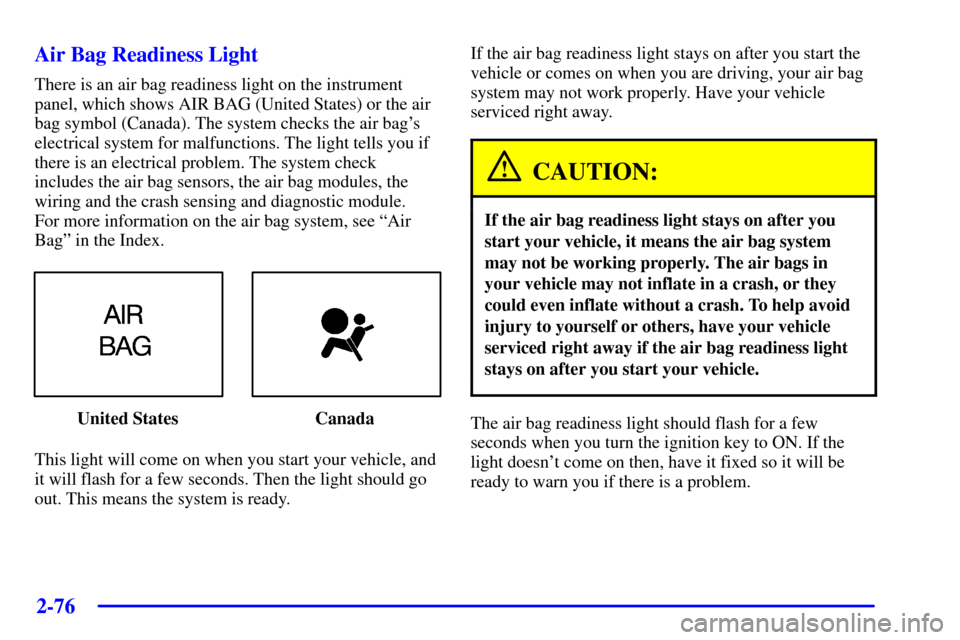Page 137 of 371
2-70
The Instrument Panel -- Your Information System
Page 138 of 371
2-71
The main components of the instrument panel are:
A. Air Outlets
B. Driver Information Center Buttons
C. Turn Signal/Multifunction Lever
D. HVAC Steering Wheel Controls (or Cellular
Telephone Controls, If Equipped)
E. Instrument Panel Cluster
F. Windshield Wiper/Washer Lever
G. Audio Steering Wheel Controls
H. Ignition Switch
I. Air Vent Control Thumbwheel
J. Hazard Warning Button
K. Audio SystemL. Lamp Controls
M. Hood Release
N. Fuel Door Release
O. Trunk Release
P. Cruise Control
Q. Horn
R. Heated Seat Controls
S. Traction Control Switch
T. Console Shift Lever
U. Convenience Storage/Optional Ashtray
V. Electronic Climate Controls
W. Glove Box
Page 139 of 371
2-72
Instrument Panel Cluster
Your instrument panel cluster is designed to let you know at a glance how your vehicle is running. You'll know how
fast you're going, how much fuel you're using and many other things you'll need to drive safely and economically.
United States version shown, Canada similar
Page 143 of 371

2-76
Air Bag Readiness Light
There is an air bag readiness light on the instrument
panel, which shows AIR BAG (United States) or the air
bag symbol (Canada). The system checks the air bag's
electrical system for malfunctions. The light tells you if
there is an electrical problem. The system check
includes the air bag sensors, the air bag modules, the
wiring and the crash sensing and diagnostic module.
For more information on the air bag system, see ªAir
Bagº in the Index.
United States Canada
This light will come on when you start your vehicle, and
it will flash for a few seconds. Then the light should go
out. This means the system is ready.If the air bag readiness light stays on after you start the
vehicle or comes on when you are driving, your air bag
system may not work properly. Have your vehicle
serviced right away.
CAUTION:
If the air bag readiness light stays on after you
start your vehicle, it means the air bag system
may not be working properly. The air bags in
your vehicle may not inflate in a crash, or they
could even inflate without a crash. To help avoid
injury to yourself or others, have your vehicle
serviced right away if the air bag readiness light
stays on after you start your vehicle.
The air bag readiness light should flash for a few
seconds when you turn the ignition key to ON. If the
light doesn't come on then, have it fixed so it will be
ready to warn you if there is a problem.
Page 173 of 371

2-106
Comfort Controls and Radio
System Personalization
These features allow both drivers to personalize their
own climate control settings as well as their radio
settings. For more information, see ªClimate Control
Personalizationº and ªRadio Personalizationº in
the Index.
The outside temperature is always available for display
if it has been selected for a DIC display when your
vehicle is running unless an overriding DIC message
appears. You can change the temperature from
Fahrenheit to Celsius by pressing the ENG/MET
(English/metric) button on the instrument panel.
For more information on the DIC, see ªDIC Messagesº
in the Index.The electronic sensor can be affected by road or engine
heat during idling, slow driving or when the engine is
first started after a short trip. To ensure proper automatic
climate control operation, the outside air temperature
display may not update as quickly as expected. This is to
allow the air surrounding the outside temperature sensor
to be as close to the actual outside conditions as
possible. This is determined by how much time has
elapsed since the vehicle has been turned off and by
vehicle speed.
Continuous Variable Road Sensing
Suspension (CVRSS) - STS Only
The CVRSS automatically adjusts the ride of your
vehicle. Automatic ride control is achieved through a
computer used to control and monitor the suspension
system. The controller receives input from various
sensors to determine the proper system response. If the
controller detects a problem within the system, the DIC
will display a SERVICE SUSPENSION SYS message.
If this message appears, have your vehicle serviced at
your dealership.
Page 175 of 371
2-108
Navigation (Option)
Navigation Display and Controls
This display screen is located in the center of the
instrument panel. There are seven ªhardº buttons and
a touch sensitive screen.Your vehicle may be equipped with a turn
-by-turn
navigation guidance system that includes a CD ROM
map media covering nine regional areas throughout
the contiguous United States. In addition, the system
includes intersection and freeway entrances, route
planning, a programmable address book, points of
interest, a list of restaurants, emergency phone numbers,
and a list of hotels and motels for all of the major
cities on each regional CD. The navigation system
can also communicate with the radio to receive
broadcast announcements on traffic, weather
information and emergency alert communications.
For information on how to use this system,
see the ªNavigationº supplement.
Page 182 of 371

3-3
Passenger's Side Temperature Knob
The right front passenger can control the temperature of
air for both the front passenger and rear seat area. (The
passenger's and driver's knob adjust from 60� F (16� C)
to 90� F (32� C) independent of each other. It is
suggested, however, that the passenger's setting stay no
more than four degrees warmer or cooler in temperature
from the driver's setting.) To turn the system on, press
the passenger's side TEMP knob. Turn the passenger's
side TEMP knob clockwise to increase the temperature
and counterclockwise to decrease the temperature. Press
the passenger's side TEMP knob again to turn off the
passenger's side system. If the passenger's side is turned
off, the driver's side will control the temperature of the
entire vehicle.
Automatic Operation
When the system is set for automatic operation, sensors
will control the air delivery mode. Air will come from
the floor, the instrument panel or windshield outlets.
The fan speed will vary as the system maintains the
selected temperature setting.
Be careful not to put anything over the electronic solar
sensors located near the ends of the instrument panel
near the windshield. These sensors are used by the
automatic system to regulate temperature.To find your comfort zone, start with the 75�F (24�C)
setting and allow about 30 minutes for the system to
regulate. Turn the TEMP knob to adjust the temperature
if necessary. If you choose 60�F (16�C), the system
will remain at that maximum cooling setting and will
not regulate fan speed. If you choose 90�F (32�C),
the system will remain at that maximum heating setting
and will not regulate fan speed. Choosing either
maximum setting will not cause the system to heat or
cool any faster.
With the automatic setting, the air conditioning
compressor cycles when needed to cool the air. In cold
weather, when the system senses the need for heat, the
airflow will be directed out the floor outlets. As the
interior temperature approaches a desired setting, the
blower speed will decrease. To maintain interior
comfort, the airflow may move to the instrument panel
air outlets and floor outlets (bi
-level mode). On bright
sunny days in cold weather, the airflow may come out of
the air conditioning outlets (A/C mode) to maintain
comfort and prevent stuffiness.
If your vehicle is sitting out on a hot day and you have it
set on AUTO, the air will first flow out the floor outlets
for a few seconds. This is normal. This is to remove hot
air from the air outlets. As the air is cooled, the airflow
will move through the air conditioning outlets.
Page 184 of 371

3-5
A/C: Press this button to turn the air conditioning
compressor on and off. When you press the button, an
A/C OFF message appears on the climate control panel's
display. Press the button again and the air conditioner
will return to automatic control. The system will cool
and dehumidify the air inside the vehicle. In the
automatic mode, the air conditioning compressor only
operates when the system determines it is needed. The
A/C OFF function is not available in the defrost mode.
MODE: Press this button (the right or left arrow) to
deliver air through the floor, instrument panel or
windshield outlets. The climate control system will stay
in the selected mode until the MODE button, the
DEFROST button or the AUTO button is pressed again.
Press the left or right arrow to cycle through the
following available modes.
UPPER: This setting directs airflow through the
middle instrument panel outlets. Your vehicle is
equipped with a driver's side lap cooler which will also
come on when the upper vents are being used.
BI-LEVEL: This setting directs air into your
vehicle in two ways. Cool air is directed to the upper
portion of your body through the four instrument panel
outlets while warmed air is directed to the floor.
DEFOG: This setting directs air to the floor
outlets and toward the windshield.
HEATER: This setting directs warmed air
through the floor outlets. Some warm air is diverted to
the windshield to minimize fogging.
FAN: The button with the fan symbol adjusts the
fan speed. Press the up arrow to increase fan speed and
the down arrow to decrease fan speed. Press the AUTO
button to set the fan speed for automatic operation. If it
is cold outside, the blower may not run in the maximum
high fan speed right away. The system checks the
temperature of the engine coolant to assure it is warm
enough to provide heat. When the engine coolant is
warm, the controller allows the fan to gradually increase
to a higher speed. This prevents cold air from blowing
into the passenger's compartment. Selecting a manual
fan speed will override this feature.